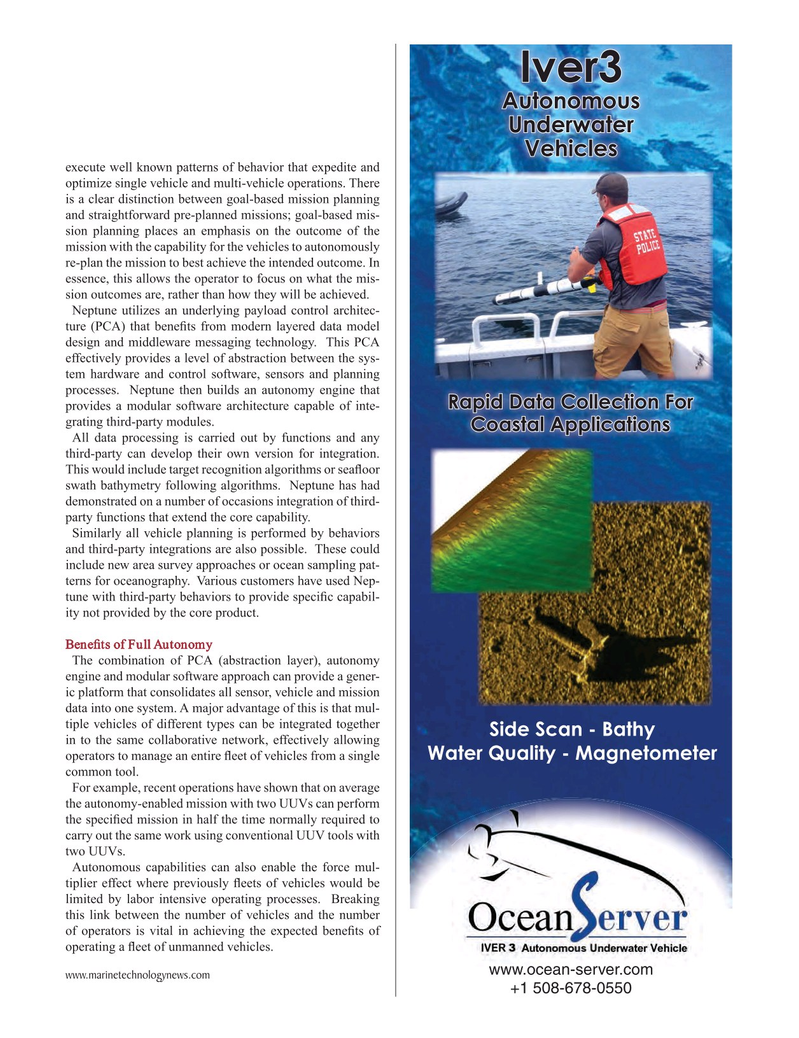
Page 39: of Marine Technology Magazine (October 2015)
AUV Operations
Read this page in Pdf, Flash or Html5 edition of October 2015 Marine Technology Magazine
Iver3
Autonomous
Underwater
Vehicles execute well known patterns of behavior that expedite and optimize single vehicle and multi-vehicle operations. There is a clear distinction between goal-based mission planning and straightforward pre-planned missions; goal-based mis- sion planning places an emphasis on the outcome of the mission with the capability for the vehicles to autonomously re-plan the mission to best achieve the intended outcome. In essence, this allows the operator to focus on what the mis- sion outcomes are, rather than how they will be achieved.
Neptune utilizes an underlying payload control architec- ture (PCA) that bene? ts from modern layered data model design and middleware messaging technology. This PCA effectively provides a level of abstraction between the sys- tem hardware and control software, sensors and planning processes. Neptune then builds an autonomy engine that
Rapid Data Collection For provides a modular software architecture capable of inte- grating third-party modules.
Coastal Applications
All data processing is carried out by functions and any third-party can develop their own version for integration.
This would include target recognition algorithms or sea? oor swath bathymetry following algorithms. Neptune has had demonstrated on a number of occasions integration of third- party functions that extend the core capability.
Similarly all vehicle planning is performed by behaviors and third-party integrations are also possible. These could include new area survey approaches or ocean sampling pat- terns for oceanography. Various customers have used Nep- tune with third-party behaviors to provide speci? c capabil- ity not provided by the core product.
Bene? ts of Full Autonomy
The combination of PCA (abstraction layer), autonomy engine and modular software approach can provide a gener- ic platform that consolidates all sensor, vehicle and mission data into one system. A major advantage of this is that mul- tiple vehicles of different types can be integrated together
Side Scan - Bathy in to the same collaborative network, effectively allowing
Water Quality - Magnetometer operators to manage an entire ? eet of vehicles from a single common tool.
For example, recent operations have shown that on average the autonomy-enabled mission with two UUVs can perform the speci? ed mission in half the time normally required to carry out the same work using conventional UUV tools with two UUVs.
Autonomous capabilities can also enable the force mul- tiplier effect where previously ? eets of vehicles would be limited by labor intensive operating processes. Breaking this link between the number of vehicles and the number of operators is vital in achieving the expected bene? ts of operating a ? eet of unmanned vehicles.
www.ocean-server.com www.marinetechnologynews.com +1 508-678-0550
MTR #8 (34-49).indd 39 9/30/2015 10:18:51 AM

 38
38

 40
40
